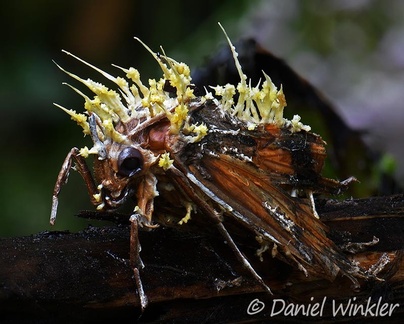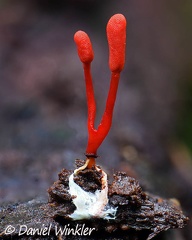
 Cordyceps caloceroides on a Tarantula seen near Pitalito
Cordyceps caloceroides on a Tarantula seen near Pitalito Gibellula pulchra growing from a tiny spider in Mocoa. Fitting species name: "pulchra" meaning beautiful in Latin. However a spider might miss the beauty aspect in a Gibellula infection.
Gibellula pulchra growing from a tiny spider in Mocoa. Fitting species name: "pulchra" meaning beautiful in Latin. However a spider might miss the beauty aspect in a Gibellula infection. Synnema with Conidiophores of Gibellula pulchra seen at Cascadas Fin del Mundo near Mocoa
Synnema with Conidiophores of Gibellula pulchra seen at Cascadas Fin del Mundo near Mocoa Ophiocordyceps amazonica seen in Isla Escondida, Putumayo
Ophiocordyceps amazonica seen in Isla Escondida, Putumayo A moth having a real bad case of Cordyceps tuberculata, the telemorph of what was formerly known as Akanthomyces pistillariiformis'
A moth having a real bad case of Cordyceps tuberculata, the telemorph of what was formerly known as Akanthomyces pistillariiformis' Beauveria sp. growing out of a mall grasshopper
Beauveria sp. growing out of a mall grasshopper Ophiocordyceps binata, aka Ophiocordyceps lloydii var binata top side
Ophiocordyceps binata, aka Ophiocordyceps lloydii var binata top side Ophiocordyceps binata seen in Mocoa
Ophiocordyceps binata seen in Mocoa Ophiocordyceps on odontomachus ant seen in Isla Escondida
Ophiocordyceps on odontomachus ant seen in Isla Escondida Cordyceps (aka Isaria) tenuipes anamorph. Most of the conidiospores already were dispersed from moving the specimen for the photo. seen in Pitalito
Cordyceps (aka Isaria) tenuipes anamorph. Most of the conidiospores already were dispersed from moving the specimen for the photo. seen in Pitalito Ophiocordyceps evansii stroma seen in Isla Escondida
Ophiocordyceps evansii stroma seen in Isla Escondida fertile head of Ophiocordyceps evansii seen in Isla Escondida. This and parasitizing species was previously clustered with O. australis, which has a round head.
fertile head of Ophiocordyceps evansii seen in Isla Escondida. This and parasitizing species was previously clustered with O. australis, which has a round head. Cordyceps nidus growing from a small spider seen in Isla Escondida, Putumayo
Cordyceps nidus growing from a small spider seen in Isla Escondida, Putumayo Beauveria diapheromeriphila, an immature specimen of this stick bug Cordyceps.
Beauveria diapheromeriphila, an immature specimen of this stick bug Cordyceps. Beauveria diapheromeriphila, the stick bug Cordyceps past prime seen in La Escondida, Putumayo
Beauveria diapheromeriphila, the stick bug Cordyceps past prime seen in La Escondida, Putumayo Ophiocordyceps engleriana fruiting on spider, note the legs, in Isla Escondida, Putumayo
Ophiocordyceps engleriana fruiting on spider, note the legs, in Isla Escondida, Putumayo Cordyceps caloceroides on a Tarantula in situ near Pitalito
Cordyceps caloceroides on a Tarantula in situ near Pitalito Ophiocordyceps unilateralis seen in Mocoa
Ophiocordyceps unilateralis seen in Mocoa Ophiocordyceps binata with scale indicating a length of 6 mm seen near Mocoa
Ophiocordyceps binata with scale indicating a length of 6 mm seen near Mocoa A past prime Ophiocordyceps binata with hyperparasite
A past prime Ophiocordyceps binata with hyperparasite